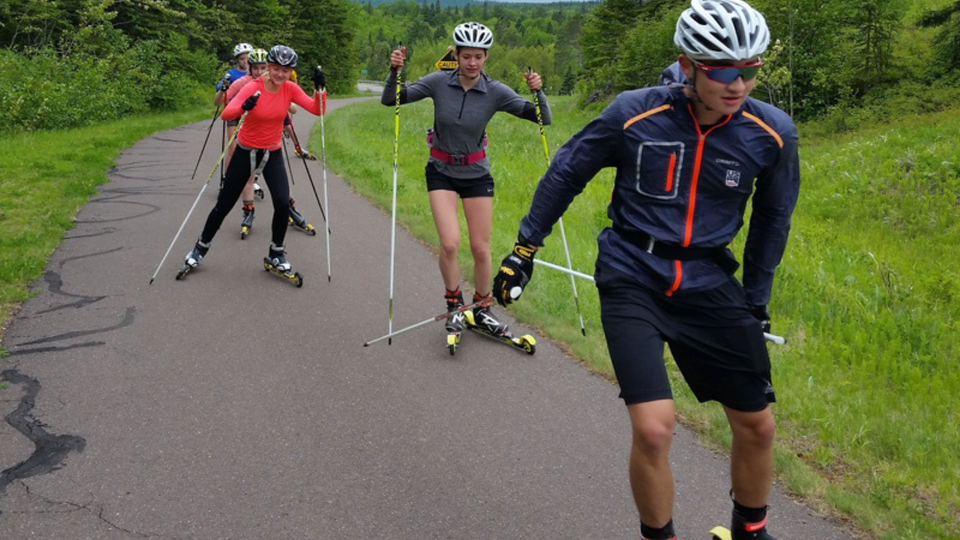Posted by Jacob Huseby on Apr 14th 2022
A How to Treat Road Rash from Rollerskiing | Swenor Rollerskis
Last week I wrote about picking out your very own set of rollerskis. A logical sequel is how to treat the road rash you will inevitably catch from looking at a stone the wrong way while out on the road.
Before we get into wound treatment, let’s talk about the other impact of a crash.
How to emotionally recover from crashing on rollerskis:
Sure, road rash can sting. But the confidence hit from falling on rollerskis can sometimes result in folks writing off the sport entirely. I have a few tips to not only recover from a fall, but to enjoy rollerskiing even more.
- Be patient with yourself. Cross country skiing takes time to learn as does rollerskiing. Even jumping between skiing on snow and rollerskiing can be tricky. Give yourself more time than you think you need to get up to speed.
- Know your course. If you want to ski in an area that you are unfamiliar with, take an afternoon and pre-ride on your bike or go out for a run. Notice any potholes, gravel patches, train tracks, steep hills that you may need to navigate while going out.
- Practice your stopping techniques. There are lots of ways to stop on rollerskis. Dragging one of your skis in gravel, v stopping, rear ski dragging, or rolling into grass can help you stop. Practice first on flat ground, then add gradually steeper hills to practice stopping from higher speeds.
- Do some agility on your rollerskis.Agility courses have become popular all around the US.NENSA (who we sponsor for rollerskis!) does a really good job promoting agility. Doing agility drills will teach you to move your skis in unconventional ways, like skiing backwards or hopping over curbs. Athletes don’t rise to the occasion; they fall back on their training. If you find you’re ever out of your depth on rollerskis, being able to move quickly will save you.
How to treat road rash from rollerskiing:
Now that you have followed my advice to go buy rollerskis and jump over curbs, lets now talk about treating road rash / recover from a fall. This is treatment for light/moderate road rash. Leave the heavy-duty stuff to the professionals and go to urgent care/ER. I am not a medical professional, but I am a pro knucklehead and have crashed my bike/skis more times than I can count.
Step 0: Get to a safe place. Assess the damage to yourself and your equipment.Stop the bleeding with pressure on the wound. If the wound does not stop bleeding, go get proper medical attention. Decide if you can ski back to your house/car or if you need to call for a ride.
Step 1: When you’re safe,wash your hands!
Step 2: Wash the affected area with water and a good soap. Skip the dial, or Irish spring. Grab a gentlecleanser like Cetaphil. If there are foreign objects (usually bits of gravel), remove them carefully.
If the wound is severe, the wound may need to be cleaned with irrigation. Clean water is necessary, saline solution is preferred. You can make saline by mixing 9 grams of salt to a liter of water. I keep it simple and wash off in the shower.
Step 3: Shave around the affected area with a clean razor. Most guides on road rash skip this step. If you have hairy legs (like me), shaving the hair on and around the affected area with a safety razor will help keep the wound clean and allow the bandage to stick. Wash again after shaving. This can also be done in the shower.
Step 4: After cleaning and shaving, apply a topical antibiotic such as bacitracin or Neosporin. Apply thin. These can be bought at any drugstore over the counter. This should not be done in the shower.
Step 5: Apply a bandage to the injury. I swear by hydrocolloid bandages. Some folks go with the 3M Tegaderm bandages. If you go to the hospital, they may give you foam dressings for heavy drainage. The purpose of these bandages is twofold: keep the wound clean and keep it moist. Keeping the wound clean will prevent infection. Keeping the wound moist will allow for faster healing and keeping the bandage from sticking. Don’t cheap out on these! I’ve run into some low-quality knock offs by trying to save a buck.
Step 6: Redress the wound as necessary. You may have to change a few times throughout the healing process. I usually go 1-3 days between redressing.
Step 7: After the wound has closed and is in the final stages of healing, apply sunscreen and moisturizer to the wound to prevent scarring. No worries if you don’t, scars are cool.
Bonus step: Watch out for tetanus! You should get a tetanus shot for the bigger hits. While most associate tetanus with rusty nails, it can also be found in dust, dirt, manure which can all be found near our favorite rollerskiing routes (especially if you’re from Wisconsin like me). Play it safe and get your shots.
Conclusion: Crashing happens to everyone, but with a few extra steps it doesn’t have to keep you down for long. Take care!

